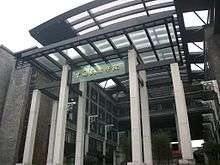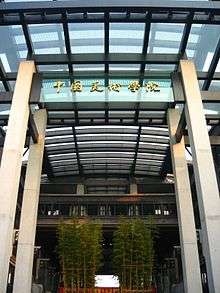China Academy of Art
China Academy of Art (Chinese: 中国美术学院), also translated as China National Academy of Fine Arts, is a fine arts college under the direct charge of the Ministry of Culture of China. It was founded in Hangzhou in 1928 by the government of the Republic of China and the renowned educator Cai Yuanpei. It was the first art university and first graduate school in Chinese history. It is a Chinese Ministry of Education Double First Class Discipline University, with Double First Class status in certain disciplines.[1]
中国美术学院 | |
| Motto | 團結 奮進 求實 創新 |
|---|---|
| Type | Public |
| Established | 1928 |
| President | Xu Jiang (许江) |
Academic staff | 500 |
| Undergraduates | 8,000 |
| Location | , China |
| Campus | Urban, Suburban |
| Colors | Black and white |
| Website | www |
| China Academy of Art | |||||||
|---|---|---|---|---|---|---|---|
| Simplified Chinese | 中国美术学院 | ||||||
| Traditional Chinese | 中國美術學院 | ||||||
| |||||||

At the time, China Academy of Art's goal was to promote fine arts education as a replacement for religion in the then war-torn China. Fine arts has been held as equal to a religion at the institution for almost eight decades. The academy has many renowned artists in its alumni and is considered one of the most prestigious art institutions in the country. It is colloquially called Guomei (國美).
Introduction
China Academy of Art is the most influential academy of fine arts with the most complete range of degree offerings and programs of study in China. It houses a diverse pool of artistic talent, has a distinctive structure integrating theory and practice, focuses on human care and social needs, and combines modern technical and cultural disciplines with traditional artistic ones. The academy features the study of theories and offering Ph.D., Master’s and bachelor's degrees of fine arts, design, architecture, film and new media, which constitute the humanities and reflect the Chinese national spirit and creative theories of the era.
There are 7,000 undergraduate and graduate students in three campuses with a faculty and staff of 800. The administration is headquartered in the Nanshan Campus, which is on the West Lake in Hangzhou. Students in the Master's program live on the alternate campus 40 minutes away, on the outskirts of Hangzhou. A free bus is offered to transport students to and from the campus from the dorms at designated times.
Undergraduate students typically spend one year in general education courses in the Department of Foundation and then three years in the core courses of their particular majors. Graduate courses are typically three years long and include experience in the studio and research with mentoring faculty.
History
In 1928, the National Academy of Art (國立藝術院) was founded in China on the bank of the West Lake in Hangzhou by the educator Cai Yuanpei with Lin Fengmian. It was administrated by Yi Tingbai and Zhuang ziman during the 1940s. Over the decades, the location of the academy has changed ten times; its name changed six times, as follows:
- 1928 - National Academy of Art (國立藝術院)
- National Academy of Art was the first Chinese art university and graduate school
- 1929 - Hangzhou National College of Art (國立杭州藝術專科學校)
- The Western painting department was divided into several studios, most of which practiced modern, semiabstract styles. The atmosphere was very similar to an American art college in its freedom of expression. After the second year of their five-year program, students chose a studio in which to continue their studies. Lin Fengmian advocated a synthesis of Chinese and modern Western art, and insisted that students not emulate his work but develop their own styles. Among the other professors, Wu Dayu taught late impressionist and cubist styles; Fang Ganmin was influenced by Cubism; and Guan Liang taught a style derived from Fauvism. Although the students were strictly trained in academic drawing, they were encouraged to be free and creative.[2]
- 1938 - National College of Art (國立藝術專科學校)
- The War of Resistance Against Japan broke out, National Peping School of Art merged into National Hangzhou School of Art, a new national school formed.
- 1945 - After the Japanese surrender in 1945, the Academy had been reestablished in Hangzhou with the Chinese painter Pan Tianshou as director.
- The establishment of the People's Republic of China saw a shift in the government's attitude to and policy on art and artistic education. Many of the senior faculty of the then National Academy of Art, particularly practitioners of modern Western art, failed to understand or refused to accept the revolutionary ideologies and principles. Many, including Lin Fengmian, Fang Ganmin, Wu Dayu and Guan Liang, gradually drifted back to Shanghai. Others, including the traditionalist Pan Tianshou, were reassigned to minor administrative positions, no longer permitted to teach. Lin Fengmian applied for permission to leave China but was refused. The vacant teaching positions were soon filled with fresh graduates who had successfully mastered revolutionary styles and principles.[3]
- 1950 - East-China Campus of Central Academy of Fine Arts (中央美術學院華東分院)
- after Chinese Civil War, CPC (中國共產黨) controlled mainland China and founded a new art academy CAFA in Beijing to cement Beijing's new capital position. As a national academy founded by the KMT (中國國民黨) government, CAA was ordered change its name to East China Campus of CAFA. CAA changed its name, but did not merge with CAFA; the two academies possess independent personalities and are not be subordinate to one another.
- similar circumstances were Shanghai Conservatory of Music (上海音樂學院), whose first name was National Conservatory of Music (國立音樂院), Shanghai Theater Academy(上海戲劇學院)were ordered change their names into East China Campus of central academies.
- 1958 - Zhejiang Academy of Fine Arts (浙江美術學院)
- 1993 - China Academy of Art (中國美術學院)
- China National Academy of Fine Arts, called China Academy of Art for short on November 16, with the endorsement of the Ministry of Culture, PRC. Finally, CAA rehabilitated its national appellation.

Campuses
- Nanshan Campus, 218 Nanshan Road, Shangcheng District, Hangzhou
- Zhangjiang Campus, Zhangjiang Hi-Tech Park, Pudong New District, Shanghai
- Xiangshan Central Campus, Zhuantang Sub-district, Xihu (West Lake) District, Hangzhou (Its south part was moved to current location in 2007 from Xihuan Road, Binjiang District.)
Colleges and departments
Nanshan Campus
School of Chinese Painting and Calligraphy (中国画与书法艺术学院)
- Department of Chinese Painting (中国画系)
- Department of Calligraphy (书法系)
School of Painting (造型藝術學院)
- Department of Oil Painting (油畫系)
- Department of Print-making (版畫系)
- Department of Mural Painting (壁画系)
- Department of Integrated Art (cuttently under development)(综合绘画系)(筹)
School of Sculpture and Public Art (雕塑与公共艺术學院)
- Department of Sculpture (雕塑系)
- Department of Public Art (公共空间艺术系)
- Department of Fiber Art (纤维艺术系)
School of Intermedia Art ([SIMA], 跨媒体学院)
- Open Media Lab (开放媒体工作室)
- Embodied Media Studio(具体媒介工作室)
- Total Art Studio (总体艺术工作室)
- Installation and Narrative Environment Studio(空间多媒体工作室)
- Experimental Image Studio (实验影像工作室)
School of Art and Humanities (藝術人文學院)
- Department of Visual Culture Studies (视觉文化系)
- Department of Art History (美术史系)
- Department of Curatorial Studies and Administration (艺术策划和行政系)
- Department of Archeology and Museology (考古与博物馆学系)
Zhangjiang Campus
Shanghai Institute of Design (上海設計學院)
- Department of Urban Space Design (城市空间设计系)
- Department of Digital Media Design (数字媒体設計系)
- Department of Fashion Product Design (时尚产品設計系)
- Department of Foundation Studies and Common Courses (公共基础教学部)
- Department of Industrial Design (工業設計系)
- Department of Urban Landscape Plastic Art Design (城市景觀造型藝術系)
- Department of Digital Publishing and Exhibition Design(數字出版與展示設計)
Xiangshan Central Campus
School of Design (設計藝術學院)
- Department of Visual Communication (视觉传达设计系)
- Department of Fashion and Textile Design (染织与服装設計系)
- Department of Industrial Design (工業設計系)
- Department of Integrated Design (綜合設計系)
- Department of Design Studies (設計艺术學系)
School of Crafts (手工藝術學院)
- Department of Ceramics (陶瓷艺术系)
- Department of Crafts(工艺美术系)
School of Film and Animation (影视与動畫艺术學院)
- Department of Animation (動畫系)
- Department of Film and Television (影视系)
- Department of Online Game Design (网游系)
- Department of Photography (摄影系)
School of Architecture (建築藝術學院)
- Department of Architectural (建築藝術系)
- Department of Urban Design (城市設計系)
- Department of Environmental Design (環境藝術系)
- Department of Landscape Architecture (景觀設計系)
School of Art Administration and Education (艺术管理与教育學院)
- Department of Art Administration (艺术管理系)
- Department of Art Education (美术教育系)
- Department of Art Appreciation (艺术鉴藏系)
Other colleges/Institutes
- International College (國際教育學院), at the Xiangshan Campus
- Chinesisch-deutsche Kunstakademie(中德学院)
- School of Foundation Studies(专业基础教学部)
Department of Fine Arts 造型分部 Department of Multimedia 图像与媒体分部 Department of Design 设计分部
- School of Adult Education or 'School of Continuing Education' (成人教育學院/繼續教育學院),on Puyan Road,Binjiang District
- The Affiliated High School 中国美术学院附属中等美术学院
- China Institute for Visual Studies 视觉中国协同创新中心
- Design Innovation Center 文创设计制造业协同创新中心
- CAA Art Museums 国美美术馆
Museum of Contemporary Art南山路美术馆 Crafts Museum 中国美术学院民艺博物馆 China Design Museum 中国国际设计博物馆
- Pan Tianshou Memorial Museum 潘天寿纪念馆
- Department of Lab Managemnet 实验教学管理部
- Department of Ideology, Political Theory and Social Sciences 思想政治社会科学教学部
- Department of Physical Education 公共体育部
- CAA Publishing House 出版社
- Library 图书馆
- New Arts 新美术(学报)
Notable alumni
- Lin Fengmian
- Fang Ganmin
- Huang Binhong, Chinese painting master
- Pan Tianshou, Chinese painting master
- Li Keran
- Dong Xiwen
- Beohar Rammanohar Sinha, modernist painter from India
- Wu Guanzhong
- Sha Menghai, calligrapher
- Zao Wou-Ki, Chinese-French modernist painter
- Chu Teh-Chun, Chinese-French modernist painter
- Wang Shu, first Chinese architect to receive the Pritzker Prize.
- Ying Miao, internet artist
- Sun Xun, visual artist
- Huang Yong Ping
- Fang Zengxian and Zhou Changgu, founders of the Zhe style
- Liu Wenxi
See also
- Chinese fine art
References
- "教育部 财政部 国家发展改革委 关于公布世界一流大学和一流学科建设高校及建设 学科名单的通知 (Notice from the Ministry of Education and other national governmental departments announcing the list of double first class universities and disciplines)".
- Andrews, Julia F. (1995). Painters and Politics in the People's Republic of China, 1949-1979. UNIVERSITY OF CALIFORNIA PRESS. pp. 46–48.
- Julia F. Andrews. Painters and Politics in the People's Republic of China, 1949-1979. University of California Press. p. 48.